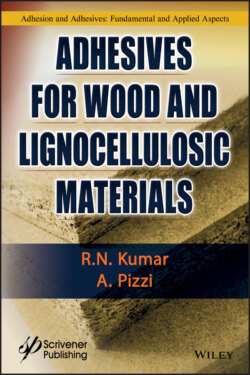Читать книгу Adhesives for Wood and Lignocellulosic Materials - R. N. Kumar - Страница 34
1.8 Influence of Resin Type and Formulation on Penetration
ОглавлениеThe penetration of adhesives in wood is influenced by the resin viscosity, its MW and MW distribution, resin solid content, and the surface tension. It has to be kept in mind that the curing process may lead to a change in the above characteristics (e.g., viscosity, MW, etc.). Hence, penetration may be influenced during the curing process. Additives that influence the curing behavior may affect the penetration [44].
Hse reported a correlation between penetration and contact angle for PF and southern pine wood [53]. The author employed 36 formulations to determine the contact angle, and its influence on cure time, heat of reaction, plywood shear strength, percent wood failure, bondline thickness, and cure shrinkage. Penetration was not measured, but assumed to be inversely proportional to bondline thickness (thickness of cured adhesive between the veneers). Penetration increased with increasing caustic content. There were no clear trends observed for penetration in relation to adhesive solids content or formaldehyde–phenol mole ratio.
In the case of powdered adhesives, such as powdered PF used in OSB manufacture, it has to melt before penetration. Johnson and Kamke [54] noted that powdered PF resin remained on the surface of wood strands during the blending process and was able to flow and penetrate only during steam injection hot-pressing.
Frazier et al. [55] noted that low MW of pMDI resin would promote penetration into wood cell walls. They further hypothesized that the MDI forms an interpenetrating network of polyurea and biuret linkages within the cell wall. Swelling of the cell wall by pMDI was also observed [48].
The use of resin with low MW components has the potential for deeper penetration than that with high MW. Stephen and Kutscha separated a commercial PF resin into two MW fractions (approximately ±1000 MW) [56]. They observed the penetration of the resin by placing a drop of resin on the surface of aspen. The authors reported that no penetration through the wood was observed for the high MW fraction of the resin, while a penetration of one to two cells deep occurred for the low MW PF fraction. The addition of NaOH improved the penetration of the high MW fraction, which the authors assumed was due to swelling of the cell wall by the NaOH. The improved penetration may also have been due to a lower viscosity as a result of NaOH addition [57]. Gollob et al. reported that PF bond performance was associated with penetration in Douglas-fir plywood [58]. They noted that higher MW formulations tended to dry out and had little penetration.
Zheng studied the penetration of the blends of MDI and PF into yellow-poplar and southern pine [59]. The penetration of the adhesive blends was characterized by a phase separation, with pMDI penetrating deeper. PF tended to bulk the lumens and remain at the interface of the bondline. In general, the blends resulted in less penetration than either of the neat resins. The author attributed the reduction in penetration to increased MW, and subsequent increased viscosity, due to the formation of urethane bonds between the PF and the PMDI.
MW distribution of resin systems will impact their ability for cell wall penetration. Laborie [32] reported evidence of cell wall penetration for two PF formulations, one that had a number average Mn of 270 and a weight average Mw of 330. The other PF had Mn and Mw values of 2840 and 14,200, respectively. The more highly condensed PF resin had a broad MW distribution, including a low Mw component that was similar to the low MW PF resin. Using dynamic mechanical analysis, the author concluded that both resin systems penetrated the cell wall.
